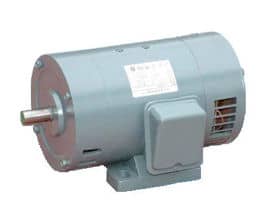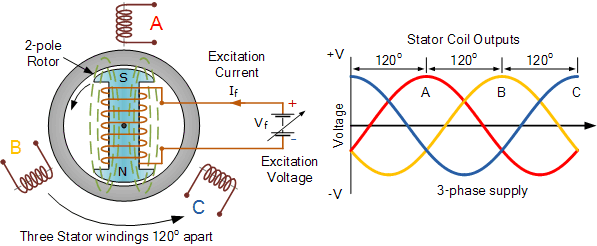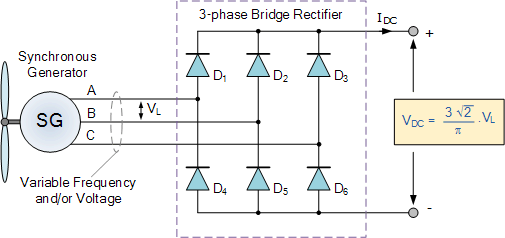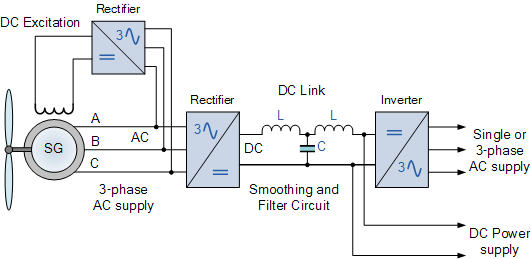
Synchronous Generator
Synchronous Generator as a Wind Power Generator
![]() Like the DC generator in the previous tutorial, the operation of a Synchronous Generator is also based on Faraday’s law of electromagnetic induction, working in a similar fashion to an automotive type alternator.
Like the DC generator in the previous tutorial, the operation of a Synchronous Generator is also based on Faraday’s law of electromagnetic induction, working in a similar fashion to an automotive type alternator.
The difference this time is that the synchronous generator generates a three-phase AC voltage output from its stator windings, unlike the DC generator which produces a single DC or direct current output. Single-phase synchronous generators are also available for low power domestic wind turbine synchronous generator systems.
Basically, the synchronous generator is a synchronous electro-mechanical machine used as a generator and consists of a magnetic field on the rotor that rotates and a stationary stator containing multiple windings that supplies the generated power. The rotors magnetic field system (excitation) is created by using either permanent magnets mounted directly onto the rotor or energised electro-magnetically by an external DC current flowing in the rotor field windings.
This DC field current is transmitted to the synchronous machine’s rotor via slip rings and carbon or graphite brushes. Unlike the previous DC generator design, synchronous generators do not require complex commutation allowing for a simpler construction. Then the synchronous generator operates in a similar way to the automotive car alternator and consists of the two following common parts:
Main Components of a Synchronous Generator
- The Stator: – The stator carries the three separate ( 3-phase ) armature windings physically and electrically displaced from each other by 120 degrees producing an AC voltage output.
- The Rotor: – The rotor carries the magnetic field either as permanent magnets or wound field coils connected to an external DC power source via slip rings and carbon brushes.
When talking about the “synchronous generator”, the terminology used for the description of the machines parts is the reverse to that for the description of the DC generator. The field windings are the windings producing the main magnetic field which are the rotor windings for a synchronous machine, and the armature windings are the windings where the main voltage is induced usually called the stator windings. In other words, for a synchronous machine, the rotor windings are the field windings and the stator windings are the armature windings as shown.
Synchronous Generator Construction

The example above shows the basic construction of a synchronous generator which has a wound salient two-pole rotor. This rotor winding is connected to a DC supply voltage producing a field current, If. The external DC excitation voltage which can be as high as 250 volts DC, produces an electromagnetic field around the coil with static North and South poles.
When the generators rotor shaft is turned by the turbines blades (the prime mover), the rotor poles will also move producing a rotating magnetic field as the North and South poles rotate at the same angular velocity as the turbine blades, (assuming direct drive). As the rotor rotates, its magnetic flux cuts the individual stator coils one by one and by Faraday’s law, an emf and therefore a current is induced in each stator coil.
The magnitude of the voltage induced in the stator winding is, as shown above, a function of the magnetic field intensity which is determined by the field current, the rotating speed of the rotor, and the number of turns in the stator winding. As the synchronous machine has three stator coils, a 3-phase voltage supply corresponding to the windings, A, B and C which are electrically 120o apart is generated in the stator windings and this is shown above.
This 3-phase stator winding is connected directly to the load, and as these coils are stationary they do not need to go through large unreliable slip-rings, commutator or carbon brushes. Also because the main current generating coils are stationary, it makes it easier to wind and insulate the windings because they are not subjected to rotational and centrifugal forces allowing for greater voltages to be generated.
Permanent Magnet Synchronous Generator
As we have seen, wound-field synchronous machines require DC current excitation in the rotor winding. This excitation is done through the use of brushes and slip rings on the generator shaft. However, there are several disadvantages such as requiring regular maintenance, cleaning of the carbon dust, etc. An alternative approach is to use brushless excitation which uses permanent magnets instead of electromagnets.
As its name implies, in a permanent magnet synchronous generator ( PMSG ), the excitation field is created using permanent magnets in the rotor. The permanent magnets can be mounted on the surface of the rotor, embedded into the surface or installed inside the rotor. The air gap between the stator and rotor is reduced for maximum efficiency and to minimise the amount of rare earth magnet material needed. Permanent magnets are typically used in low power, low cost synchronous generators.
For low speed direct drive wind turbine generators the permanent magnet generator is more competitive because it can have higher pole number of 60 or more poles compared to a conventional wound rotor synchronous generator. Also, the excitation implementation with permanent magnets is simpler, more durable but does not allow control of excitation or reactive power. The one major disadvantage of permanent magnet wind turbine synchronous generators is that with no control of the rotor flux, they attain their peak efficiency only at one pre-defined wind speed.
The Generators Synchronous Speed
The frequency of the output voltage depends upon the speed of rotation of the rotor, in other words its “angular velocity”, as well as the number of individual magnetic poles on the rotor. In our simple example above, the synchronous machine has two-poles, one North pole and one South pole. In other words, the machine has two individual poles or one pair of poles, (North-South) also known as pole pairs.
As the rotor rotates one complete revolution, 360o, one cycle of induced emf is generated, so the frequency will be one-cycle every full rotation or 360o. If we double the number of magnetic poles to four, (two pairs of poles), then for every revolution of the rotor, two cycles of induced emf will be generated and so on.
Since one cycle of induced emf is produced with a single pair of poles, the number of cycles of emf produced in one revolution of the rotor will therefore be equal to the number of pole pairs, P. So if the number of cycles per revolution is given as: P/2 relative to the number of poles and the number of rotor revolutions N per second is given as: N/60, then the frequency, ( ƒ ) of the induced emf will be defined as:

In a synchronous motor, its angular velocity is fixed by the frequency of the supply voltage so N is commonly known as the synchronous speed. Then for a “P”-pole synchronous generator the speed of rotation of the prime mover (the turbine blades) in order to produce the required frequency output of either 50Hz or 60Hz of the induced emf will be:
At 50Hz
| Number of Individual Poles | 2 | 4 | 8 | 12 | 24 | 36 | 48 |
| Rotational Speed (rpm) | 3,000 | 1,500 | 750 | 500 | 250 | 167 | 125 |
At 60Hz
| Number of Individual Poles | 2 | 4 | 8 | 12 | 24 | 36 | 48 |
| Rotational Speed (rpm) | 3,600 | 1,800 | 900 | 600 | 300 | 200 | 150 |
So for a given synchronous generator designed with a fixed number of poles, the generator must be driven at a fixed synchronous speed to keep the frequency of the induced emf constant at the required value, either 50Hz or 60Hz to power mains appliances. In other words, the frequency of the emf produced is synchronised with the mechanical rotation of the rotor.
Then from above, we can see that to generate 60 Hz using a 2-pole machine, the rotor must rotate at 3600 revs/min, or to generate 50 Hz using a 4-pole machine, rotor must rotate at 1500 revs/min. For a synchronous generator that is being driven by an electrical motor or steam generator, this synchronous speed may be easy to achieve however, when used as a wind turbine synchronous generator, this may not be possible as the velocity and power of the wind is constantly changing.
We know from our previous wind turbine design tutorial, that all wind turbines benefit from the rotor operating at its optimal tip speed ratio. But to obtain a TSR of between 6 to 8, the angular velocity of the blades is generally very low around 100 to 500 rpm, so looking at our tables above, we would require a synchronous generator with a high number of magnetic poles, eg, 12 or above.
But as well as that, some form of mechanical speed limiter such as a Continuously Variable Transmission, or CVT would be required to keep the rotor blades rotating at a constant maximum speed for a direct drive wind turbine system. However, for a synchronous machine, the more poles it has the larger, heavier and more expensive becomes the machine which may or may not be acceptable.
One solution is to use a synchronous machine with a low number of poles which can rotate at a higher speed of 1500 to 3600 rpm driven through a gearbox. The low rotational speed of the wind turbines rotor blades is increased through a gearbox which allows the generator speed to remain more constant when the turbines blade speed changes as a 10% change at 1500rpm is less of a problem than a 10% change at 100rpm. This gearbox can match the generators speed to variable rotational speeds of the blades allowing for variable speed operation over a wider range.
However, the use of a gearbox or pulley system requires regular maintenance, increases the weight of the wind turbine, generates noise, increases power losses and reduces system efficiency as extra energy is required to drive the gearboxes cogs and internal components.
There are many advantages to using a direct drive system without a mechanical gearbox, but the omission of a gearbox means a larger synchronous machine with an increase in both size and cost of the generator, which then has to operate at a low speeds. So how can we operate a synchronous generator in a low speed wind turbine system whose rotor blade speed is determined only by the winds power. By rectifying the generated 3-phase supply into a constant DC or direct current supply.
Synchronous Generator Rectifiers
Diode rectifiers are electronic devices used to convert AC (alternating current) into DC (direct current). By rectifying the power output from the synchronous generator into a DC supply, the wind turbine generator may be operated at different speeds and frequencies other than its fixed synchronous speed.
This allows the variable frequency and variable voltage output of the generator to be converted into a DC voltage of a variable level. By rectifying the output from AC into DC, the generator can now be used as part of a battery-charging wind systems or as part of a variable-speed wind power system. Then the synchronous generator of an alternating current is transformed into a generator of a direct current.
The simplest type of rectifier circuit uses a diode bridge circuit to convert the AC generated by the generator into a fluctuating DC supply whose amplitude is determined by the generators speed of rotation. In this synchronous generator rectifier circuit shown below, the generator’s 3-phase output is rectified to DC by a 3-phase rectifier.
Generator Rectifier Circuit

The circuit diagram of the full-bridge, three-phase, AC to DC rectifier is shown above. In this configuration, the wind turbine can operate the generator at a frequency independent of the synchronous frequency as changing the generator speed varies the generator frequency. Hence it is possible to vary the speed of the generator over a wider range and to run at the optimal speed to obtain the maximum power depending on the actual wind speed.
Note that the output voltage from the 3-phase bridge rectifier is not pure DC. The output voltage has a DC level together with a large AC variation. This waveform is generally known as “pulsating DC” which can be used to charge batteries but can not be used as a satisfactory DC supply. In order to remove this AC ripple content a filter or smoothing circuit is used. These smoothing circuits or ripple filter circuits use combinations of Inductors and Capacitors to produce a smooth DC voltage and current.
When used as part of a grid-connected system, synchronous machines can only be connected to the mains grid, when their frequency, phase angle, and output voltage are the same as the grids, in other words they are rotating at their synchronous speed as we have seen above. But by rectifying their variable output voltage and frequency into a steady DC supply, we can now convert this DC voltage into an AC supply of the correct frequency and amplitude, matching that of the mains utility grid by using either a single-phase or 3-phase inverter.
An Inverter is a device that converts direct current (DC) electricity to alternating current (AC) electricity which can be fed directly into the mains grid as grid-connected inverters operate in sync with the utility grid and produce electricity that’s identical to utility grid power. Grid-connected sine-wave inverters for wind systems are selected with an input range that corresponds to the rectified output voltage of the turbine.
Then the advantage of an indirect grid connection is that it is possible to run the wind turbine at variable speeds. Another advantage of rectifying the output from the generator is that wind turbines with synchronous generators which use electromagnets in their rotor design, can use this DC to supply the coil windings around the electromagnets in the rotor. However the disadvantage of indirect grid connection is the cost as the system needs an inverter and two rectifiers, one to control the stator current, and another to generate the output current as shown below.
Synchronous Generator Circuit

Tutorial Summary
The wound rotor synchronous generator is already being used as a wind power turbine generator, but one of the major disadvantage of a synchronous generator can be its complexity and cost. Gearless direct drive generators are very slow turning synchronous generators with large numbers of poles in order to reach their synchronous speed. Generators with fewer poles have higher rotational speeds so require a gearbox or drive train adding to the cost.
Synchronous generators produce electricity whose fundamental output frequency is synchronised to the rotational speed of the rotor. Grid-tied generators require a constant fixed speed to synchronise with the utility grid frequency and it is necessary to excite the rotor winding with an external DC supply, using slip rings and brushes.
The major disadvantage of one fixed-speed operation is that it almost never captures the wind energy at the peak efficiency. The wind energy is wasted when the wind speed is higher or lower than the certain value selected as the synchronous speed.
Variable speed wind turbines use rectifiers and inverters to convert variable voltage, variable frequency output of the synchronous generator into the fixed voltage, fixed 50Hz or 60Hz frequency output required by the utility grid. This allows for permanent magnet synchronous generators to be used reducing the cost. For low speed direct drive wind turbine generators the permanent magnet generator is more competitive because it can have higher pole number of 60 or more poles compared to a conventional wound rotor synchronous generator.
In the next tutorial about Wind Energy and Wind Turbine Generators, we will look at the operation and design of another type of electrical machine called the Induction Generator, also known commonly as an “Asynchronous Generator”. Asynchronous generators can also be used for generating three-phase grid connected AC electricity.
To learn more about “Synchronous Generators”, or obtain more wind energy information about the various wind turbine generating systems available, or to explore the advantages and disadvantages of using synchronous generators as part of a grid connected wind turbine system, Click Here to get your copy of one of the top Synchronous Generator and Motor books today direct from Amazon.











How can I reference your article as there is no name?
good
Thank you for this excellent article over viewing the different methods of generation and connection. I found the information on Synchronous Generators especially helpful. I added this article to my bookmarks. I am an inventor and work designing Mega Watt windmills
how is generator rotor speed is maintained constant when wind speed is changing which changes rotor speed of wind turbine which in turn changes the rotor speed of the generator
when wind speed changes wind turbine rotational speed changes which in turn changes the rpm of the generator rotor.But how you are telling that rpm of generator is fixed and wont change.
Synchronous Generators are “synchronised” (hence their name) with the mains supply before connection. During the start-up or low wind speed, the rotor speed and therefore the stator frequency is different from the mains supply frequency. Therefore a synchronous generator needs to be synchronised first using an external DC current to excite the rotor field as explained in the tutorial. Asynchronous electrical machines do not require any such synchronisation process.
KAKOOSIL THOORI NJAN
Sir . What is beetween difference pmg and emg
PMG means: Permanent Magnet Generator
EMG means: Electric or Electrical Motor Generator
Can we connect the fluctuating AC input of wind turbine synchronous generator to AVR for voltage regulation .??? Some of these AVR gives constant 220 V with the input goes down to 90 V ???
An Automatic Voltage Regulator, or AVR, takes a fluctuating voltage input and turns it into a constant voltage output, so it could, in theory, be used with a wind turbine generator. But there are many types of AVR’s so please consult the manufacturers datasheet first.
Thank you for the response .
I will try to get more info on those AVRs.
Could we connect PMSG with diode rectifier and only capacitor in dc link ..then inverter to the grid…without chopper or any power electronic in dc link??
I didn’t find any topology like that in research papers.
Yes, AC is converted to DC by rectifier and capacitor smooths the DC for the inverter.
Hi guys:
If we can make power converter to get dc by using diodes as bridge rectifier, can we use diodes to make power inverter?? If that is possible,please releated diagram??
Diodes can not convert DC to AC.
Hi guys:
Can we hook up the power inverter directly to the bridge rectifier outlet (and a smoothing capacitor in between if possible) to get ac power outlet..? In any of the wind turbine systems???
Thank you
Yes you could do that.
By power inverter i meant the ones that used with batteries . I think those ones should have stable inlet 12,24 or 48 volts ???
And another thing, What if we connect the AVR directly to the variable frequency /voltage AC inlet to get stable AC .??? In some AVR it is said that it can produce constant 220 volts output even with inlet drops up to 100 volts????
Consult the manufacturers specifications of the inverter
I am trying to find out how much the actual rotor or generator ways that produces 1.5 – 2 MW of power.
Sir I want 1500watt 24v to 40v brush less wind turbine generator. This type of motor i want to e-bike. If you have this type of motor, give me information and details.
I am looking for a genhead for making a tidal stream generator 10kw: any suggestion ..please.
So what really is the advantages of using synchronous generators for wind power systems, in both family scale and medium size scale ?
Will the harmonics due to uncontrolled rectifier circuit affect the permanent magnet?
No, any harmonics generated due to the switching of the rectifier will be on the output side.
In the top 10 of my favorite articles, thanks!
So does this PSMG required a gearbox?
Not clear about that
Hi Ken, It really depends on the type of permanent magnet synchronous generator you have and the speed at which it needs to rotate. The low rotational speed of the wind turbines rotor blades can be increased through the use of a gearbox which will allow the generator speed to remain more constant, but the downside is that a gearbox will reduce efficiency as extra wind energy is required to drive the gearboxes cogs.